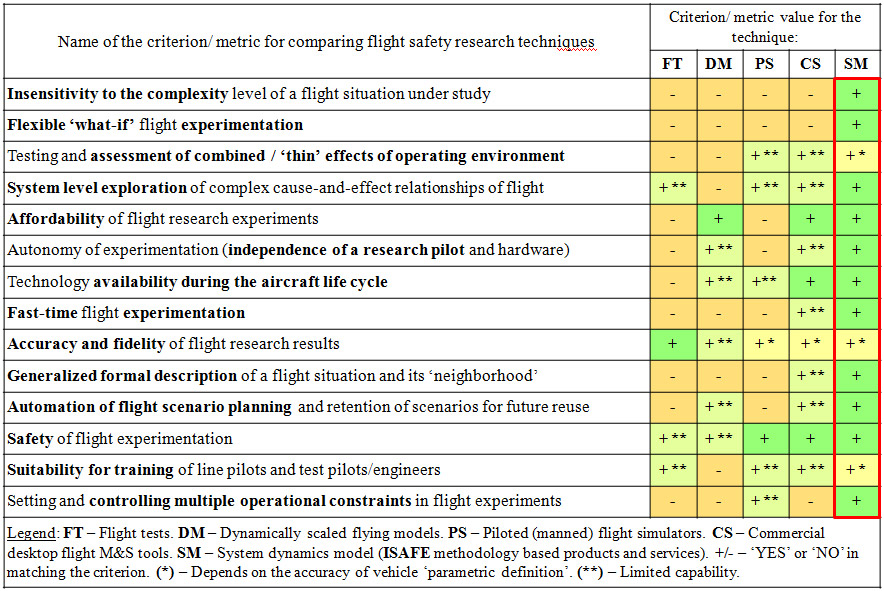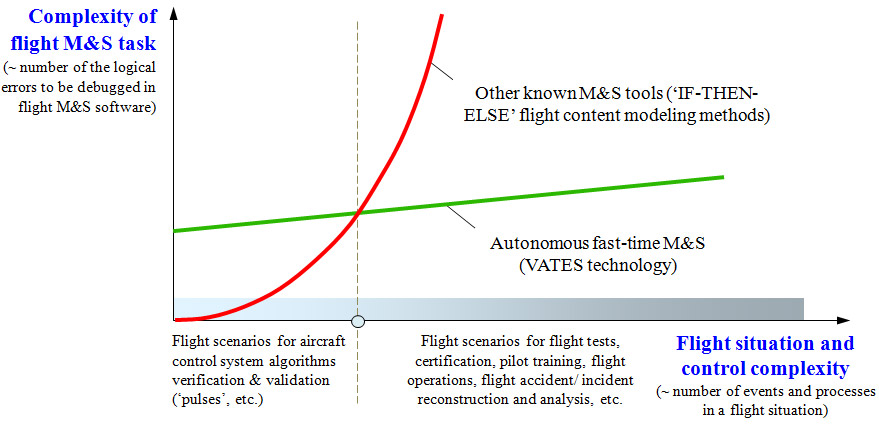Existing Techniques vs. ISAFE-VATES Technique In Flight Safety Research
Virtual Flight Test and Operation Environment
ISAFE-VATES Based Safety Risk Analysis Process
- Develop the ‘parametric definition’ and implement the system dynamics model for a vehicle of interest.
- Select and formalize operational factors for examination in fast-time M&S experiments.
- Plan and debug baseline flight situation scenarios.
- Plan and debug a multifactor situational tree ‘genotype’ – a multifactor operational hypothesis.
- Select knowledge maps to represent the safety performance of a complex flight domain of interest as a ‘bird’s eye view’ picture.
- Carry out the system model validation using available real or simulated flight data for a prototype.
- Run autonomous fast-time flight M&S experiments to construct a situational tree.
- Map the tree’s ’what-if’ branching crown onto integral safety spectra and/or other knowledge maps.
- Screen the simulated domain of multifactor flight situations using the selected knowledge maps.
- Generate (‘mine’ and ‘granulate’) new system-level knowledge on the vehicle flight safety performance in multifactor situations from M&S data.
- Identify (if any) and quantify anomalies/ unsafe scenarios and accident precursors in the system dynamics using knowledge maps and virtual flight experiment statistics.
- Identify and quantify safe situations, their precursors and control scenarios.
- Explore accident avoidance/recovery control (or, if required, remedial design solutions) to avoid ‘chain reaction’ anomalies in the system behavior in multifactor situations.
- Develop recommendations on flight safety enhancement in the multifactor operational domain of interest; recommendation options:
- refine operational constraints (less expensive, time- and budget-wise, recommendation), and/or
- modify piloting tactics, operational procedures, and/ or
- modify automatic flight control laws, and /or
- make changes to the dirigible design – aerodynamics / propulsion / structure (most expensive, time- and budget-wise, recommendation).
NOTE: the steps of input and output data preparation, data processing and results description are omitted.
Distinguishing Features of ISAFE Methodology
- Generalized model of the ‘pilot – vehicle – operating environment’ system dynamics.
- Compact and efficient data structures.
- A generalized language to formalize flight scenarios.
- A generalized algorithm to plan complex operational hypotheses for simulation.
- Use of any situation scenario as a tree’s trunk.
- Built-in fatigue-free ‘silicon pilot’ model.
- Algorithms for automated exploration of ‘what-if’ branching domains of multifactor flight.
- Algorithms for automatic ‘mining’ of safety knowledge from simulation raw data.
- Algorithms and formats for automatic mapping of safety knowledge.
Distinguishing Features of VATES Technology
- (100 … 200)´N times increase in the speed of complex flight simulation compared to real-time, where N is the number of computers in use.
- 104 … 105 times increase in the volume and diversity of new knowledge on the system dynamics in multifactor situations.
- Relaxation of the ‘curse of dimensionality’ in flight simulation research.
- Capability of virtual flight test beginning from early design of a vehicle.
- Capability of accident reconstruction and ‘what-if neighborhood’ analysis under uncertainty.
- Protection of the confidentiality of the customer’s database on the vehicle under study.
- Capability of proactive research into multifactor flight safety for accident prevention.
- Accumulation of a library of flight scenarios and multifactor hypotheses for future reuse.
ISAFE-VATES : Main Advantage and Main Limitation
Main advantage: The complexity of a flight scenario planning and simulation task does not depend on the complexity of the multifactor flight situation under examination.
Main limitation: In order to obtain reliable engineering results from ISAFE-VATES-based flight safety research, it is required to have a complete ‘parametric definition’ (input characteristics) database of the vehicle for all the flight regimes of interest.
| << Previous page | Next page >> |



